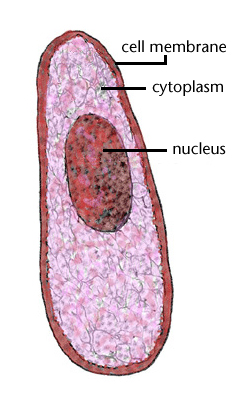
With a single lens, the scientist Robert Hooke, (1635–1703), began the exploration of the parts of a cell. From the small single-celled amoebas right up to elephants and oaks there are some features that all cells share.

Examining cork, Hooke could make out the individual compartments that were the borders of each cell. As microscopes became better and newer, techniques were discovered to add more details to the cell. Better resolution, magnification, and staining techniques all helped.
While there are some distinct differences between animal and plant cells, they do have a lot of common features. Each needs an outer covering, a border between the inside and outside of the cell. This border needs to be able to allow the passage of materials in and out of the cell for life processes to work. This border is called a cell membrane and both plant and animal cells have it.
Most cells (but not all) also have a nucleus which controls the functions of the cell. The nucleus is a large slightly darker mass found near the center of most cells.
The rest of the cell contains little structures called organelles. They have specific purposes within the cell, like the organs in your own body. We will be getting into the specific functions of organelles in another lesson. Organelles float in a substance called cytoplasm; this is the substance between the cell membrane and the nuclear membrane that gives the cell shape and supports the organelles.
| Continue |